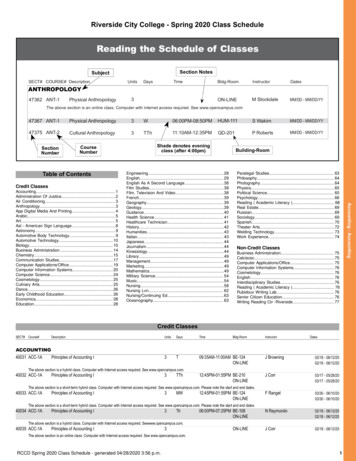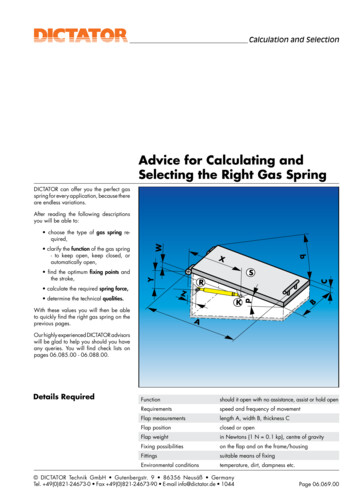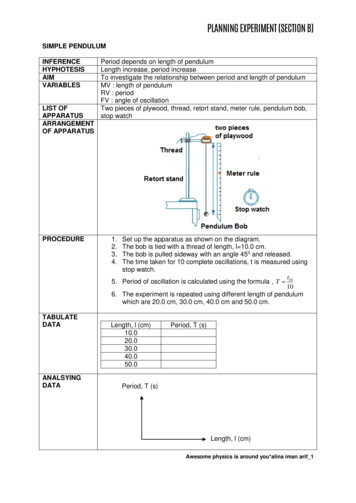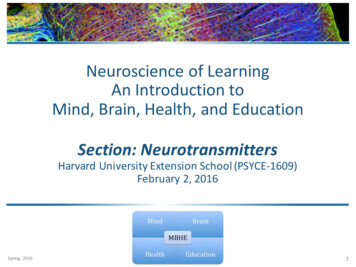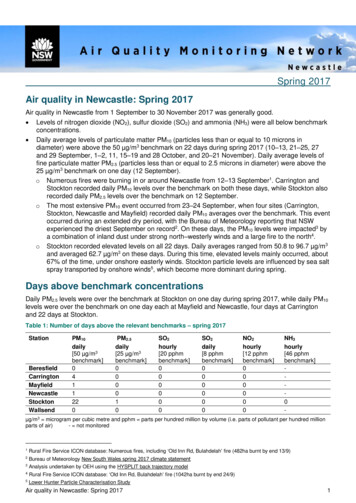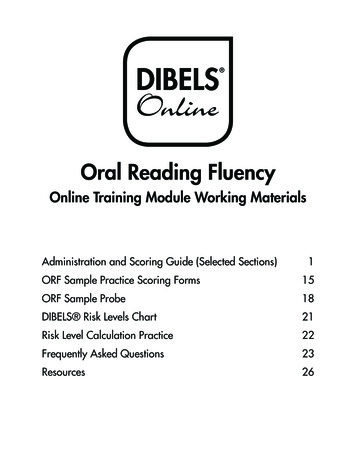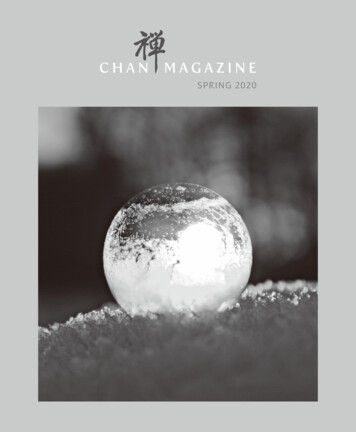
Transcription
SPR ING 2020
Master Huineng – The Sixth Patriarch of ChanPortrait by Chien-Chih LiuThe Chan school has a saying, “No reliance on words andscriptures.” In other words, Chan does not recommendrelying solely on the Dharma of teachings. But the curiousfact is that the Chan patriarchs and masters left behind moreteachings than any other school of Buddhism. For thirtyyears, I have been all over the world saying that the mindDharma cannot be spoken. And yet the purpose of all of thiswriting and teaching is to teach people not to rely on words.CHAN MASTER SHENG YENSeven-day retreat in Moscow, May 2003
Volume 40, Number 2 — Spring 2020CHAN MAGAZINEPUBLISHED QUARTERLY BYInstitute of Chung-Hwa Buddhist CultureThe Mind Dharma of the Sixth PatriarchChan Meditation Center (CMC)BY Chan Master Sheng Yen90-56 Corona AvenueElmhurst, NY 11373FOUNDER / TEACHERChan Master Venerable Dr. Sheng YenADMINISTRATORVenerable Chang HwaEDITOR-IN-CHIEFBuffe Maggie LaffeyART DIRECTORShaun ChungCOORDINATORChang JiePHOTOGRAPHY AND ARTWORKCOVER ARTCONTRIBUTING EDITORSCONTRIBUTORSRikki Asher, Kaifen Hu, Taylor MitchellPhoto by RihaijDavid Berman, Ernie Heau, Guo GuVenerable Chang Ji, Venerable Chang Zhai,Verse on No-Form412BY Chan Master HuinengThe Message of the Platform Sutra18BY Guo GuThe Legacy of the Platform Sutra26BY Dan StevensonOnline Retreats, Workshops & Group Meditation37Chan Meditation Center Affiliates38Rebecca Li, David Listen,Ting-Hsin Wang, Bruce Rickenbacker,Dharma Drum Mountain Cultural CenterCHAN MEDITATION CENTER(718) 592-6593DHARMA DRUM PUBLICATIONS(718) g/en/publication/chan-magazine/The magazine is a non-profit venture; it accepts no advertising and is supportedsolely by contributions from members of the Chan Meditation Center and thereadership. Donations to support the magazine and other Chan Center activitiesmay be sent to the above address and will be gratefully appreciated. Please makeArticles published in Chan Magazine contain the views of their authorschecks payable to Chan Meditation Center; your donation is tax-deductible.and do not necessarily represent the views of Dharma Drum Mountain.
The Mind Dharma ofthe Sixth PatriarchbyCHAN MASTER SHENG YENIn May of 2003, Master Sheng Yen presented a seven-day Chanretreat in Moscow at the invitation of the Wujimen Martial ArtsGroup. For his morning, afternoon, and evening talks, Master ShengYen chose as one of his main themes the teachings of Sixth PatriarchHuineng on the practice of “no-form” as expressed in the PlatformSutra. (Master Sheng Yen’s talks during the retreat were concurrentlytranslated into English by Dr. Douglas Gildow.) The full text of MasterSheng Yen’s talks on that retreat was published serially in ChanMagazine beginning with the Autumn 2004 issue. For this special issuededicated to the teachings of Huineng, we have compiled excerpts fromthe talks, wherein Master Sheng Yen talks about Huineng’s teaching onthe practice of “formlessness.” The excerpts were compiled and editedfor brevity by Ernest Heau. ( There being much to absorb here, werecommend to readers to treat this text as a resource to return to often.)4Master Huineng and Master HongrenArt by Chien-Chih Liu
Mastery of the Teachings,Mastery of MindIt has already been one day and I believethat most of us have not brought peace to our mind.We are having conflicts with wandering thoughtsand with our body. Originally wanting to be liberated from the self, we find that the self is still quiteimportant to us. We start by seeking the joy of liberation but the first thing we encounter is sorrowand suffering. This proves that we are ensnared bythe body and the mind and not actually in controlof ourselves. According to the belief in ShakyamuniBuddha’s time, to be fully liberated meant becoming an arhat by transcending the birth-and-deathcycle of samsara, and entering nirvana. Typicallythis could only be done if one was a monk or nun.But to Huineng, anyone who practiced in accordancewith the principle of no-form could be liberated.Liberation meant that one no longer has vexationsand is no longer influenced by the environment,but one also remains in the world to help others.This is the way of the bodhisattva – liberation doesnot require ordination nor does one need to leavethis world.Let us look at the idea of form in relation totime as well as space. In the temporal aspect, everythought that we have is a form that relates to the past,present, or future. On retreat, we practice droppingthoughts of past and future and just keeping our mindin the present, with the ultimate goal of droppingeven thoughts in the present mind.In the spatial aspect, forms relate to oneself and toothers. In other words, all sentient beings are forms.We should understand that anything we perceive isconstantly changing, impermanent and without inherent self-nature. Self, others, and sentient beings areall objects of perception and likewise impermanent.6Chan Master Sheng YenDDM Archive PhotoSo the temporal aspect of form relates to thoughtsof past, present, and future, and the spatial aspectrelates to self and other sentient beings. Nevertheless, the forms in time and space are completelyinterlinked and it is impossible to draw a firm linebetween the two. But all forms in time and space areimpermanent, which means that they are empty ofself-nature and ultimately formless.The words from the Diamond Sutra, “abiding nowhere, give rise to mind,” means that one must realize– not just know intellectually – that forms in time aretransient and ultimately lack self-nature. Likewise,spatial forms are also in flux, impermanent, and lackself-nature. For these reasons, one does not abide informs of time or space, and does not cling to them.“Give rise to mind,” refers to the spontaneousarising of wisdom when we do not cling to forms.But wisdom itself is a form, so one does not abide init either, and one does not attach to it. Instead, onegoes beyond wisdom to realize no-mind. This nomind is the no-form, or formlessness, that Huinengspeaks of in the Platform Sutra.Let’s now look at the first line of Huineng’s verse:Mastery of the teachings and mastery of mind are likethe sun in the empty sky. However, to have mastery ofeither the teachings or the mind, you must actuallyexperience the mind Dharma. If you can directlymaster the mind Dharma, there is no need to studythe Dharma of the teachings. Otherwise, one shouldbegin with the Dharma of teachings to ultimately realize the mind Dharma. At that time you will see thatthe Dharma of the teachings and the mind Dharmaare one and the same. In other words, we use thelanguage and concepts of the teachings to reach whatis ultimately beyond language and concepts.So far, have I been talking about Dharma of theteachings, or about the mind Dharma, or both? Well,the answer is that so long as we use language andconcepts, we can only talk about the Dharma of theteachings. The Chan school has a saying, “No reliance on words and scriptures.” In other words, Chandoes not recommend relying solely on the Dharmaof teachings. But the curious fact is that the Chanpatriarchs and masters left behind more teachingsthan any other school of Buddhism. For thirty years,I have been all over the world saying that the mindDharma cannot be spoken. And yet the purpose ofall of this writing and teaching is to teach people notto rely on words.Realizing No-FormWhen we speak of the mind not abiding anywhere, itdoes not mean that your mind has no thoughts whatsoever. It does not mean that when you see someoneyou should not act like you did not see them, or if youhear something there is no sound, or if you’re eating you don’t taste anything. No, non-abiding meansthat you’re clearly aware of phenomena but are notentangled in them; you are not caught up in craving, hatred, likes and dislikes, doubt, arrogance orjealousy, and so on. If these states of mind arise thenimmediately return to your method to remove suchvexations. This way, even if you cannot fully realizenon-abiding you can at least practice it.Our emphasis on this retreat is not particularlyon sitting but on practicing Chan in daily life. Ofcourse the longer you can sit the better; but do notforce yourself. Is it true then, that we don’t actuallyneed sitting meditation? Would we be just as well ifwe lay down on a sofa or on a floor practicing thisway? In principle that is true. In fact, sick peopleconfined to bed can practice. But most people willquickly enter into a stupor and perhaps fall asleep.Or if they don’t fall asleep, they’ll have all kinds ofscattered thoughts. Instead, if we sit or move we canbe aware of the sitting or the movements. So, it’s bestif during our practice we can feel the body. The bodyis a tool to help us train the mind. Without the bodyit’s very difficult to train the mind.In Chan, daily life itself is practice and the earlymasters did not encourage practitioners to do muchsitting meditation. Huineng himself did not do sitting meditation and neither did some of his famousdisciples, such as Huairang and Qingyuan. This is notto say that we do not use our body at all. We use thebody as a tool for practice, but sitting meditation isnot the whole of practice. If sitting meditation simplySPRING 20207
8enlightenment is attainable, most people need touse the gradual approach. However, even in gradualpractice, there is a precondition to train the mind sothat it can be known and be put down.Dharma on all sentient beings. Just as the sun illuminates everything, the functions of wisdom andcompassion can also influence all beings. Huineng’ssun is thus an analogy of the functions of wisdomand compassion.Since there is no obstruction to emptiness, wespeak of the empty sky whose lack of obstructionscan be called “silence.” The arising of this sun-likewisdom and compassion through realizing emptinessis called “illumination.” We can say therefore, thatthis line describes realization in silent illumination.On one hand the sky is unobstructed – this is silence;on other hand the sun is shining on all beings – thisis illumination. When illumination is developed toits highest point, silence will necessarily be present.The reverse is also true: when silence is at its deepestlevel, illumination will also be present.Like the Sun in an Empty SkyIn the first line from our text, “mastery of the teachings” refers to the language and concepts of theDharma, and “mastery of the mind” refers to the mindDharma, or enlightenment. Mastery of the teachings and mastery of mind are ultimately one andthe same, and for one who has attained this state,the mind is like “the sun in an empty sky.” The sunrepresents buddha-nature or emptiness, and justas nothing can obstruct emptiness, in an empty skynothing obstructs the brilliance of the sun. Thereis not actually a thing called buddha-nature. However, in realizing emptiness one uses the functionsof wisdom and compassion to shine the light ofLet Go of All Forms,Let Affairs Come to RestPhoto by Julien Di Majoturns into an exercise in training our legs, then it isuseless. But if we use the body as a tool for trainingour mind it can be very useful.Those who don’t sit at all and those who areoverly attached to sitting are both incorrect. Whenwe have the proper attitude sitting is a relatively easyway to stabilize our confused minds. Therefore, sitting is still important. If, however, during regulardaily life you can maintain a calm and stable mind,then, when sufficient causes and conditions mature,one can attain enlightenment that way. However, aprecondition for this path to enlightenment is to havea clear understanding of emptiness, no-self, and nomind. Without this understanding, even with a calmand stable mind, one cannot become enlightened.To realize no-mind and no-form, one must havea clear and continual awareness of mind and forms.Before one can do that, one must start with a stablemind. With a busy and confused mind, one does notknow what mind itself is, and one does not knowwhat the so-called forms oftime and forms of space are.Merely conceptual knowledge of emptiness, no-self,and no-mind is of limiteduse. It is only knowledge, notreal experience.Daily life is practice.However, because mostpeople’s minds are confused,there is a need for places likeChan halls for meditating.Most people are unable intheir daily life to stabilizeand calm their mind orperceive the true emptiness of forms. While thereis no doubt that suddenTo practice well, we must learn to relax. When wecannot relax our body, we also find it difficult to relaxour mind. If we have expectations, then we’re seeking something. If we have fear, we’re rejecting something or we lack security. This results in nervousnessand tension. Being unsatisfied and having cravingsmeans we have a seeking mind, and that will makeus nervous. We can see therefore that relaxation isnot just concerned with the muscles; it also involvesour thoughts, concepts, and emotions. We have toput them all down to fully relax. When we can dothat all the time, we will have no more vexations andwe will be on the path of liberation.After learning how to relax, you should applytwo rules in your practice. The first is: “Let go ofall forms.” Forms can be understood generally asphenomena or objects of perception. So, letting goof all forms means realizing formlessness. So, pleaselet go of all forms. The second rule is: “Let all affairscome to rest.” This means putting down all mentaland bodily concerns.If you can do this completely you will realize nomind. At this point, in a way of speaking, you havenothing to do; there is nothing good or bad, important or unimportant, to do for yourself or others. Atthis time you are truly relaxed and you have beenable to put down everything. Please keep remindingyourself to apply these two rules.“Let go of all forms; let all affairs come to rest.”When you are vexed, when you feel pain, fear,or any kind of unease, you can repeat these ruleslike a mantra and remind yourself of their meaning. If you do that your attitude and mental situationwill change. So, to realize the formless Dharma, thefirst step is to let go of forms. One-by-one, let go offorms, beginning with wandering thoughts, especiallythoughts of past and future. Put down thinking aboutpast and future and stay only in the present. If youare doing sitting meditation, your mind should beonly on sitting. The same applies to working, walking, eating, drinking, exercising, chanting, or doingprostrations. Experience these activities fully, thesensations that come with them, and be aware ofyour mental reactions in the process. If you can letgo of the past and the future and put your mind totally in the present, you have at least relinquishedthe forms of time.Emptiness of the Dharma of MindWhen he was still at Huangmei, the monasteryof Fifth Patriarch Hongren, Huineng worked inthe kitchen milling rice. As a method for finding his Dharma heir, Hongren, who was the abbot, asked the monks to write a verse expressingSPRING 20209
their own understanding of Dharma. None of themonks were willing to do this except the headmonk, Shenxiu, who, when the other monks wereasleep, wrote a verse on the wall in the Chan hall.It went like this:The body is a bodhi tree,The mind is a bright mirror.Always diligently polish the mirror,And do not let dust collect.“The body is a bodhi tree” means that we use thebody as the foundation through which we cultivateenlightenment. The second line, “The mind is a brightmirror,” means that the mind is like a mirror thatreflects what is in front of it without adding any selfcentered view. If you can imagine it, the mind is likea circular mirror that can reflect everything aroundit, in 360 degrees. The meaning of the third line, “Always diligently polish the mirror” is that we shouldbe diligent in using Dharma methods to dissipateor eliminate vexations and wandering thoughts. Thefourth line, “And do not let dust collect” says that oneshould work hard to train the mind so that it does notpermit vexations to stain our clear, mirror-like mind.So, please everyone, take a guess. Does thispoem express a realization of formlessness? Doesit demonstrate a true understanding of the Dharmaof mind? Yes or no?Audience: “No.”But does this poem express something good? Yes,of course it does. Practitioners need to behave likethis. In any case, according to the Platform Sutra, atthis time Huineng had already realized the Dharmaof mind when he heard someone quote from theDiamond Sutra. Being illiterate, Huineng asked oneof the monks to read him Shenxiu’s verse on the wall.That night, after hearing Shenxiu’s verse, Huineng10asked one of the monks to write the following lineson the wall, next to Shenxiu’s verse:Bodhi is originally without a tree,The mirror is also without a stand.Originally there is not a single thing.Where is there a place for dust to collect?“Originally there is not a single thing,” means thatthere are no real substantial forms, called “bodhi,”“buddha-nature,” or “emptiness.” Huineng is sayingthat bodhi is not a substantial thing. People oftenthink that enlightenment is an experience in whichwe can feel a certain thing, or discover exactly whatthis “thing,” enlightenment, is. This is an incorrectview because enlightenment, or seeing self-nature,is an experience of emptiness. It is the experience ofphenomena as being empty and insubstantial. MostEastern and Western philosophies and religions believe in a highest or ultimate reality to which theygive names such as oneness or God. Actually, weenter this oneness when we experience unified mindin meditation. In the West it may be called oneness,but according to the Chan Dharma, we need to putdown or let go this unified mind. We do not want tothink of this unified mind as the highest or ultimatetruth. But how do we get to what is highest truth?We have to drop everything, and then we will cometo the point of formlessness or non-attachment to allforms. Forms are products of causes and conditions.As such they are changing and non-substantial. Theystill exist; it is just that the enlightened mind doesnot abide in them.This idea of formlessness is different from theories that postulate an original substance or an originalcause. In contrast, Buddhadharma advocates the ideathat everything arises because of causes and conditions, and is therefore empty, or formless. Now, let’scompare the emptiness of the Dharmaof the teachings with the emptiness thatis actualized in the Dharma of mind. Theemptiness of the Dharma of teachings isarrived at through logical deduction oranalysis, and in both cases we are usingthe mind to reach understanding.On the other hand to have an actualrealization of emptiness we use methodssuch as silent illumination or huatou, andwhen our mind reaches a unified statewe want to put down this unified mind.However, we cannot just put down theunified mind at will; we need to repeatedly use our methods, again and again.When conditions in our practice matureand we encounter some kind of acutestimulus – certain sounds, words, orsights – all doubts and questions may suddenlydisappear. Or perhaps we are suddenly able to putdown our already stabilized mind, and all thoughtsinstantly disintegrate and shatter. It is as if we havejust broken through a silk cocoon in which we havebeen confined. Not only has the cocoon disappearedbut the silkworm has also disappeared. We are freeof all burdens. Everything still exists but there is noself; that is to say, there is no clinging nor vexationsassociated with our “self ”.’ This emptiness is reachedthrough spiritual practice, and is different from theemptiness reached through analysis or logic.When seeing self-nature, one realizes that allphenomena are insubstantial and that the self hasalways been non-existent. At this time one is ableto put down all attachments. However, sooner orlater, depending on the person and the depth of theexperience, one’s self-centeredness and attachmentswill return. Therefore, it is extremely important forthe individual to continue using methods of practice.Photo by Ilya LixFor example, if one is in the stage of watching thehuatou, and if one continues to practice at this level,it is possible to have similar experiences, and one’srealization will become deeper and deeper. Not allpeople however, are able to repeat the experiencelike this. Regardless of whether one can repeat it ornot, the experience of seeing self-nature is extremelyvaluable. Although one still has self-centeredness,many vexations will have been eliminated. Havingexperienced putting down one’s mind, one will alsodevelop a high degree of self-confidence and neveragain lose one’s spiritual practice. This experience islike suddenly seeing light for the first time. Althoughthe light will fade or disappear, the individual willstill know what that light is, because he or she hasactually seen it. Something like this happens whensomeone experiences seeing self-nature or emptiness. A shallow experience of enlightenment can becalled seeing self-nature, while a deeper experienceof enlightenment can be called liberation.SPRING 202011
Chan Magazine is pleased to offer this new English rendition of Chan Master Huineng’s“Verse on No-Form,” based on the Zongbao version of the Dharma-Jewel Platform Sutraof the Sixth Patriarch, by contributing editor Ernest Heau and Wee Keat Ng.In 2016, while reading English translations of the “Verse on No-Form,” (from Chapter 2 of thePlatform Sutra) Ernest Heau felt that some of them aspired more towards literal accuracy thantowards “poetic” considerations such as rhythm, cadence, symmetry between lines, recitability,ease of memorization, and so on. And yet, according to the sutra, Huineng explicitly exhortedhis followers to recite and memorize the “Verse on No-Form.”Ernest thought that coming up with a more “verse-like” English version would be a worthwhileeffort. Not being literate in Chinese, his best recourse was to consult seven different Englishtranslations, three commentaries on the verse by Chinese masters (including Master ShengYen), Chinese Buddhist dictionaries, and several translation websites, to create his own version.The focus of his effort was strictly on the sixty lines of five characters each that comprise the“Verse on No-Form,” from Chapter 2 on Prajna.In 2019, Ernest decided that to ensure that his rendition was faithful to the original text, athorough review of every stanza, line, and word was needed. His good fortune was to convinceMr. Wee Keat Ng, an experienced translator of Buddhist texts, to collaborate on such a task.Working together by email over several months, Ernest and Wee Keat arrived at a new versionwhich underwent many changes and revisions in achieving what they believe to be an authenticnew English rendition of Huineng’s “Verse on No-Form.” Ernest and Wee Keat extend theirthanks to Ming Yee Wang and David Listen for their kindness in reviewing drafts and offeringsuggestions which improved the final version.12SPRING 202013
14SPRING 202015
Translations of the Platform Sutra Consulted Sutra Spoken by the Sixth Patriarch, Wong Mou Lam (Yu Ching Press, 1930) Ch’an and Zen Teaching, Series Three, Charles Luk (Lu Kuan Yu) (Rider, 1962) The Platform Sutra of the Sixth Patriarch,Philip Yampolsky (Columbia University Press, 1967) Platform Sutra of the Sixth Patriarch,Bhikshuni Heng Yin (Buddhist Text Translation Society, 1971) The Sutra of Hui-neng, Grand Master of Zen,Thomas Cleary (Shambhala Dragon Editions, 1998) The Platform Sutra of the Sixth Patriarch, John McRae (BDK America, 2000) The Platform Sutra of the Sixth Patriarch Huineng,[translator(s) not named] (Chung Tai Translation Committee, 2009)Commentaries of the Platform Sutra Consulted The Sixth Patriarch’s Dharma Jewel Platform Sutra:With the Commentary of Venerable Master Hsüan Hua,translated by Bhikshuni Heng Yin (Buddhist Text Translation Society, 2002) The Commentary on the “Formless Gatha” by Master Yung Hsi,translated by Chou Hsiang-Kuang (Yuan Yin Buddhist Institute, 1956) The Mind Dharma of the Sixth Patriarch by Master Sheng Yen,translated by Douglas Gildow (Dharma Drum Publishing, 2006)16SPRING 202017
Ican’t emphasize enough how importantthe Platform Sutra is within the Chan and Zentraditions. Without understanding the key principlesof Huineng’s scripture, one would not be truly bepracticing Chan. The Platform Sutra condenses theChan positions on the nature of mind, the nature ofpractice, our relationship with objects and people,and the nature of texts – everything is condensed ina very terse, direct way.The most important message of this scripture,and indeed of the whole Chan tradition which makesit distinct from other forms of Buddhist practice, isthe teaching on no-thought (wu nian), no-form (wuxiang), and non-abiding (wu zhu). These three principles refer to how we relate to the world of externaland internal appearances, and to our true nature.They are the principles one embraces before realizing awakening, which is to say, before seeing one’strue nature. One is always stumbling over these threeprinciples, resisting them, following one’s own instinctual, self-referential, habitual vexations. Theseprinciples are therefore something with which wemust again and again realign ourselves.These three principles also serve as guides topost-awakening practice. Most people’s awakeningexperiences, in the larger Buddhist tradition, refer tothe experience of no-self, selflessness, and freedomfrom self-referentiality where there is no greed, craving, aversion or anger, and no ignorance. This, veryspecifically, is the state of nirvana, or awakening toliberation. A passage from Chapter Four talks aboutthe three concepts:The Message of thePlat form SutrabyGUO GUBBackgroundPhoto by Joel & Jasmin Førestbird18TCC Archive Photoeginning on April 14, 2017 Guo Gu (aka Prof. Jimmy Yu of Florida StateUniversity) gave six weekly talks on the Platform Sutra at the TallahasseeChan Center, of which he is founder and resident teacher. This articleconsists of passages from the first three of those talks, as excerpted andedited by Victor Lapuszynski and Buffe Maggie Laffey. The quoted passagesare about teachings on no-thought, no-form, and non-abiding and are takenfrom The Platform Sutra of the Sixth Patriarch (Numata Center for BuddhistTranslation and Research, 2006), translated by John McRae from the 1291edition of Master Zongbao ( Taishō Volume 48, Number 2008).Good friends, since the past this teaching ofours has first taken nonthought as its centraldoctrine, the formless as its essence, andnonabiding as its fundamental. The formless isto transcend characteristics within the contextof characteristics. Nonthought is to be withoutthought in the context of thoughts. Nonabidingis to consider in one’s fundamental nature that allworldly [things] are empty, with no considerationof retaliation - whether good or evil, pleasant orugly, and enemy or friend, etc., during times ofwords, fights, and disputation.No-ThoughtNo-thought does not mean cutting off thinking. Howdoes one practice no-thought amidst the free flow ofthoughts? Here, the expression “thoughts” has twolevels of meaning. The first means our mental processes, our brain’s natural ability to think, symbolize,conceptualize, perceive. The second refers to fixations of constructs, our tendency to reify thoughtsor ideas into discrete realities as things. The practiceof no-thought amidst thought means to not reify, solidify, congeal, or trust our own concepts of things asreality, without blocking the natural flow of thinking.We generally believe that the way we think aboutourselves is how we actually are. We cannot distinguish between our thoughts and the reality of whowe are. If we’re feeling negative, we don’t see anythinggood about ourselves. When we’re in a good mood,even a shortcoming is adorable. This projectionhappens so quickly that we don’t usually recognizeit. But this subtle feeling is what the passage abovecalls “thought.” So when you feel something within,you should recognize it but don’t reify, identify, andsolidify it into thing. Definitely don’t build a wholenarrative around it. This is the meaning of practicing“no-thought” amid thoughts. It’s learning to have ahealthier relationship with our thoughts, instead ofbeing conditioned by them.Of course, people who have had awakening experiences still have thoughts. Yet their thoughts areSPRING 202019
self-liberating. The way they relate to the world andto their own perception and cognitive processes hasbeen transformed. They would not do such foolish things as following their own discursive thinking, or reifying their views and opinions as if thatreflects reality.The FormlessRegarding no-form, the Platform Sutra says, “Theformless is to transcend characteristics within the contextof characteristics.” It is to be formless amidst forms.The Chinese word for “form” is xiang, which hasan array of implications and meanings, sometimestranslated as “form,” sometimes understood as “appearances,” “characteristics,” or “objective realities.”When are we free from objective reality, appearances, forms, and characteristics? Never. You look atme now, this is a characteristic, an appearance. I lookat you and all the multitude of colors, shapes, andfeatures, all that is included in form. Amidst forms,there is the formless. What does that mean?interior processes. The formless turns the spotlightto the external world. They’re the same thing. Twosides of the same coin. We can reify our own ideas;we can definitely reify forms.That’s why from the Chan school’s perspectivethere is no need for us to disengage with the world.No need to move out into the wilderness, no needto be a hermit. Where is chan then? In the midst ofform. How? Don’t be disturbed. When you’re disturbed, you’re attached. There is subject and thereis object. When you are disturbed, you have fixednotions. Think
Volume 40, Number 2 — Spring 2020 CHAN MAGAZINE PUBLISHED QUARTERLY BY Institute of Chung-Hwa Buddhist Culture Chan Meditation Center (CMC) 90-56 Corona Avenue Elmhurst, NY 11373 FOUNDER / TEACHER Chan Master Venerable Dr. Sheng Yen ADMINISTRATOR Venerable Chang Hwa


